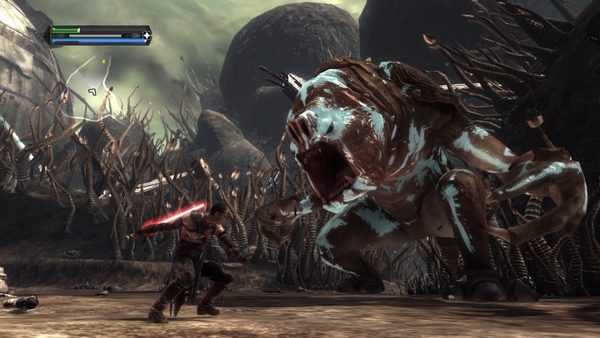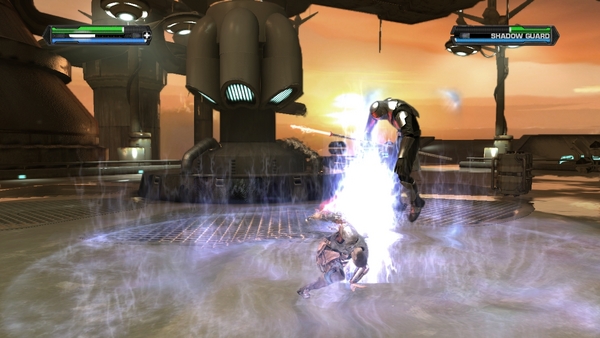Sometimes I like to sit back and revisit old games from previous console generations, just to see whether or not they still hold up. Some do, others give you a new appreciation for how far gaming has evolved over the years. Star Wars: The Force Unleashed falls into the latter camp.
EA’s newest Star Wars game, Jedi: Fallen Order, is proving to be a surprise hit, in a franchise that has been battered and bruised since Disney took it over in 2012. Indeed, the last really adult oriented, single player Star Wars game was The Force Unleashed II, which came out way back in 2010. Which marks the widest gap between such triple A releases in galactic history. But we’re not looking at that game. Today, we’ll be looking at the first entry in the brief series, which stands as a shrine to the decay of LucasArts.
The Force Unleashed was originally planned as part of a multimedia series, much like LucasFilm had done with Shadows of the Empire. Though it never really saw much attention in that regard, with a book and a handful of comics releasing outside of the two games. The premise of the story sounds cool at first. The orphaned son of a Jedi gets taken in by Darth Vader and raised to be his secret Sith apprentice. However, he gets pulled back to the light by an ex-Jedi soldier and goes on to somehow inspire the founding of the Rebel Alliance. Apologies for the spoilers, but the game is 11 years old at this point.
I was never a fan of Galen “Starkiller” Marek though. He’s sort of that generic video game hero that appeared all too often in that particular era. It’s hard to really form much of a connection to him or his story. Which for what it’s worth, is as generic as its protagonist. That’s not to say I hate it. It’s certainly far better than any of the mouse turds Disney has pooped out over the last four years, The Mandalorian notwithstanding. It’s just never really pulled me in. Especially compared to other legendary releases in the franchise’s gaming wing that came out only a few years earlier.
However, it seems LucasArts decided that story was mostly secondary to gameplay mechanics and technology they wanted to show off. At least, that’s what the marketing focused on. It was intended to be the ultimate Jedi Knight power fantasy. Where you can unleash devastating Force attacks against objects and enemies, who react realistically to your actions.

In reality though, The Force Unleashed was a standard issue God of War clone. You hacked and slashed your way through largely linear levels, and fighting big bosses along the way. However, the game lacked the finesse of GoW. Galen’s controls and combos weren’t quite so refined compared to that of Kratos. Making the game challenging, but in a cheap way. Attacks never really feel like they’re connecting, while enemies get consistent hits. Meanwhile, Force powers frequently go off in unintended directions. It seems like you’re always fighting the controls. Gameplay is, simply put, frustrating.
And let us not forget the one cardinal sin of games from this era: quick time events. The game uses them frequently for boss fights. The window for selecting the right button is pretty small, and if you slip up, you have to repeat the entire sequence. There’s only a select few games where this mechanic is satisfying, and Force Unleashed is not one of them. Especially coming off my playthrough of the PS3 Yakuza games, everything about the combat just feels incredibly unsatisfying, even for its time. It certainly doesn’t hold up today.
But what about all that technology that LucasArts was showcasing? There’s two major things here: Euphoria and Pixelux’s “Digital Molecular Matter” (DMM for short).
Eurphoria is an AI engine that’s intended to allow non-player characters to react in a realistic fashion to player actions. Rather than a set of predefined rag doll animations, they respond dynamically, so that no two play sessions are alike. At least that’s what it claims on the back of the box. It’s tough to really see the system working during game play. Perhaps because such systems are so deeply ingrained into modern games, that I just don’t notice it anymore. Indeed, Euphoria was later baked into the RAGE engine used in GTA V and Red Dead Redemption. It’s worth noting that this only applies for standard enemies. Bosses still fight using predictable patterns, for the most part.

The real impressive tech though is DMM. It’s a physics engine that allows objects to break and deform in a realistic manner. Destructible 3D environments weren’t new at this point. Red Faction had done it on the PS2 several years early, but this moved the technology to the next level. If you threw an object at a pane of glass, it would shatter accordingly, radiating out from the impact site. And it would do this no matter where you hit the glass. Same with metal objects like doors and walls. They’d bend, dent, and twist like their real world counterparts would if they were subject to comparable force. It’s something we still don’t see in a lot of modern games, so it’s really fun to play around with.
Unfortunately, DMM seems to have just disappeared from gaming after The Force Unleashed II came out. It did see use in the film industry up until 2013, and won an Academy Award in 2015. Pixelux’s website hasn’t been updated since, suggesting the project is now dead. The Force Unleashed stands as the technology’s only real contribution to video games. Which again, is a shame.
So does Force Unleashed hold up today? You’ve probably guessed that no, no it does not. While it certainly packed some impressive technology for 2008, it’s gameplay has aged like fine milk. I started playing it for this article, but couldn’t put it down quick enough. The tech isn’t enough to overcome its shortcomings. The frustrating gameplay and long load times for just about everything, even opening menus. Plus the second level on Raxus Prime still wants to make me pull my hair out. There were other, better games like it when it was new, and there are certainly far better games out today. Heck, even some older Star Wars games still manage to blow the doors off it. Try picking up the Jedi Knight series instead if you’re looking for some vintage force fueled power fantasies.
Images via Steam, used under fair use (as I have no way to take screenshots off PS3).





